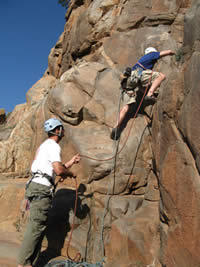Difference between Mountain Climbing and Rock Climbing
Key Difference: Mountain Climbing is a sport or hobby in which a person hikes or climbs a mountain. It is also known as mountaineering or alpinism. Rock Climbing is a sport that requires a person to climb up and down a rock formation or a rock wall. Rock climbing or scaling is a part of mountain climbing where a person may be required scale rocks to get a certain peak when climbing a mountain.
Mountain climbing and rock climbing are two outdoor activities that are often confusing for people that do are not familiar with such sports. In reality, they are the same thing and they are different from each other. Confused? Let’s clarify. Rock climbing is actually a sub category of mountain climbing. Mountain climbers have to face rock climbing if they are going during the spring or summer time, where they may be required to scale slope rocks to climb to the top. However, rock climbing is also different as it mountain climbing is a bigger concept and also includes ice climbing, hiking, trekking, etc. Rock climbing only requires people to scale rocks to get to a certain peak.
Outdoor activities such as climbing or hiking have been arranged in many rating systems and the most common one used is the Yosemite Decimal System. The activities have been divided into classes from 1-5 on the basis of difficulty and experience level required. Climber.org lists the five classes as:
- Class 1: Walking with a low chance of injury.
- Class 2: Simple scrambling, with the possibility of occasional use of the hands. Little potential danger is encountered.
- Class 3: Scrambling with increased exposure. A rope can be carried but is usually not required. Falls are not always fatal.
- Class 4: Simple climbing, with exposure. A rope is often used. Natural protection can be easily found. Falls may well be fatal.
- Class 5: Technical free climbing involving rope, belaying, and other protection hardware for safety. Un-roped falls can result in severe injury or death.
 Mountain Climbing is a sport or hobby in which a person hikes or climbs a mountain. It is also known as mountaineering or alpinism. The term ‘alpinism’ is a European word that was derived in the 19th century to refer to climbing a mountain for the purpose of enjoying climbing. Mountain climbing originally began as a way to climb the highest mountain, reach the highest peak and go somewhere no one has gone before. This later branched into a sport and activity and has been categorized in to specializations that deals with different aspects of the mountain and consists of three areas: rock, snow and ice. All three requires a different skill-set, equipment, experience and athletic ability.
Mountain Climbing is a sport or hobby in which a person hikes or climbs a mountain. It is also known as mountaineering or alpinism. The term ‘alpinism’ is a European word that was derived in the 19th century to refer to climbing a mountain for the purpose of enjoying climbing. Mountain climbing originally began as a way to climb the highest mountain, reach the highest peak and go somewhere no one has gone before. This later branched into a sport and activity and has been categorized in to specializations that deals with different aspects of the mountain and consists of three areas: rock, snow and ice. All three requires a different skill-set, equipment, experience and athletic ability.
Depending on the range (snow, ice or rock), a climber would carry his equipment. Climbing in snow requires poles and the journey is commonly done by walking or hiking. It climbing is done on ice or rock; it requires the person to carry ropes, picks, carabineers and other such equipment. Rock and ice climbing also requires scaling the ice or rock, which is mostly straight up or at an angle. Mountain climbing is done in groups of experience people as there are more changes of a person getting seriously hurt. Mountain climbing can take one day to many days. In one day the person reaches a destined point and then comes back, while in a multi-day trip the person camps at locations in the middle before continuing on.
There are two styles of mountaineering: Expedition style and Alpine style. Expedition style is a longer journey and is made up for large groups. It requires climbing large mountains and the journey is usually slow and they require more supplies. They may also use porters, pack animals, glacier airplanes, cooks, multiple carries between camps, etc. Alpine style is a relatively shorter journey with smaller groups climbing medium-size mountains. Steven Cox and Kris Fulsaas list the two in their book ‘Seattle: The Mountaineers’.
Expedition style
- Uses multiple trips between camps to carry supplies up to higher camps
- Group sizes are often larger than alpine style climbs because more supplies are carried between camps
- Fixed lines are often used to minimize the danger involved in continually moving between camps
- Supplemental oxygen is frequently used
- Higher margin of safety in relation to equipment, food, time, and ability to wait out storms at high camps
- Avoidance of being trapped in storms at high altitudes and being forced to descend in treacherous avalanche conditions
- Possible higher exposure to objective hazards such as avalanches or rockfall, due to slower travel times between camps
- Higher capital expenditures
- Longer time scale
Alpine style
- Climbers only climb the route once because they do not continually climb up and down between camps with supplies
- Fewer supplies are used on the climb therefore fewer personnel are needed
- Alpine style ascents do not leave the climber exposed to objective hazards as long as an expedition style climb does; however, because of the speed of the ascent relative to an expedition style climb there is less time for acclimatization
- Supplemental oxygen is not used
- Danger of being trapped at high altitude due to storms, potentially being exposed to HAPE or HACE
- Lower capital expenditures
- Shorter time scale

Rock Climbing is a sport that requires a person to climb up and down a rock formation or a rock wall. Rock climbing or scaling is a part of mountain climbing where a person may be required scale rocks to get a certain peak when climbing a mountain. However, rock climbing is not only limited to rock formations in the wilderness or rocks of a mountain. A person can also climb artificial rocks in an indoor rock wall. It is similar to rock climbing in nature but it has artificially placed footing that allows the climber an easy access and is also comparatively easier. Though rock climbing is not an Olympic sport, it is recognized as a sport by the International Olympic Committee.
Rock climbing gradually evolved from alpinism, where people would scale and climb the rock on the Alps to get to the top. It slowly became popular and now is considered as a sport in itself and separate from mountaineering. Rock climbing has been divided into grades to measure the difficulty of the routes. There are many different styles of rock climbing including Aid climbing, bouldering, deep-water soloing, free climbing, free soloing, indoor climbing, sport climbing, top-rope climbing, etc. Climbing requires a proper set of gear and materials. Also amateur climbers are often advised to go with a leader or an experience person. Rock climbing requires equipment such as rope, carabiners, helmet, harness, quickdraws, rappel devices or descenders and climbing shoes.
Image Courtesy: forums.watchuseek.com, frontrangeclimbing.com









Add new comment